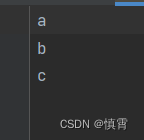Java之IO流(其他流)
一、缓冲流
(一)、概述
缓冲流,也叫高效流,是对4个基本的
FileXxx?流的增强,所以也是4个流,按照数据类型分类:
- 字节缓冲流:
BufferedInputStream,BufferedOutputStream- 字符缓冲流:
BufferedReader,BufferedWriter
????????缓冲流的基本原理,是在创建流对象时,会创建一个内置的默认大小的缓冲区数组,通过缓冲区读写,减少系统IO次数,从而提高读写的效率。
(二)、字节缓冲流
底层自带了长度为8192的缓冲区提高性能
1、构造方法
public BufferedInputStream(InputStream in)?:创建一个 新的缓冲输入流。public BufferedOutputStream(OutputStream out): 创建一个新的缓冲输出流。
// 创建字节缓冲输入流
BufferedInputStream bis = new BufferedInputStream(new FileInputStream("bis.txt"));
// 创建字节缓冲输出流
BufferedOutputStream bos = new BufferedOutputStream(new FileOutputStream("bos.txt"));2、read和write方法


(三)、字符缓冲流
1、构造方法
public BufferedReader(Reader in)?:创建一个 新的缓冲输入流。public BufferedWriter(Writer out): 创建一个新的缓冲输出流。
// 创建字符缓冲输入流
BufferedReader br = new BufferedReader(new FileReader("br.txt"));
// 创建字符缓冲输出流
BufferedWriter bw = new BufferedWriter(new FileWriter("bw.txt"));2、特有方法
- BufferedReader:
public String readLine(): 读一行文字。
- 一次读一行,遇到回车换行结束,但是不会把回车换行读到内存中
- BufferedWriter:
public void newLine(): 写一行行分隔符,由系统属性定义符号。
public class BufferedWriterDemo throws IOException {
public static void main(String[] args) throws IOException {
// 创建流对象
BufferedWriter bw = new BufferedWriter(new FileWriter("out.txt"));
// 写出数据
bw.write("a");
// 写出换行
bw.newLine();
bw.write("b");
bw.newLine();
bw.write("c");
bw.newLine();
// 释放资源
bw.close();
}
}

二、转换流
(一)、InputStreamReader类
转换流
java.io.InputStreamReader,是Reader的子类,是从字节流到字符流的桥梁。它读取字节,并使用指定的字符集将其解码为字符。它的字符集可以由名称指定,也可以接受平台的默认字符集。
1、构造方法
InputStreamReader(InputStream in): 创建一个使用默认字符集的字符流。InputStreamReader(InputStream in, String charsetName): 创建一个指定字符集的字符流。
InputStreamReader isr = new InputStreamReader(new FileInputStream("in.txt"));
InputStreamReader isr2 = new InputStreamReader(new FileInputStream("in.txt") , "GBK");(一)、OutputStreamWriter类
转换流
java.io.OutputStreamWriter?,是Writer的子类,是从字符流到字节流的桥梁。使用指定的字符集将字符编码为字节。它的字符集可以由名称指定,也可以接受平台的默认字符集。
1、构造方法
OutputStreamWriter(OutputStream in): 创建一个使用默认字符集的字符流。OutputStreamWriter(OutputStream in, String charsetName): 创建一个指定字符集的字符流。
OutputStreamWriter isr = new OutputStreamWriter(new FileOutputStream("out.txt"));
OutputStreamWriter isr2 = new OutputStreamWriter(new FileOutputStream("out.txt") , "GBK");read方法和write方法都差不多就不写了?
三、序列化
(一)、概述
????????Java 提供了一种对象序列化的机制。用一个字节序列可以表示一个对象,该字节序列包含该
对象的数据、对象的类型和对象中存储的属性等信息。字节序列写出到文件之后,相当于文件中持久保存了一个对象的信息。????????反之,该字节序列还可以从文件中读取回来,重构对象,对它进行反序列化。
对象的数据、对象的类型和对象中存储的数据信息,都可以用来在内存中创建对象。
(二)、ObjectOutputStream类
java.io.ObjectOutputStream?类,将Java对象的原始数据类型写出到文件,实现对象的持久存储。
1、构造方法
public ObjectOutputStream(OutputStream out): 创建一个指定OutputStream的ObjectOutputStream。
FileOutputStream fileOut = new FileOutputStream("employee.txt");
ObjectOutputStream out = new ObjectOutputStream(fileOut);2、序列化操作
一个对象要想序列化,必须满足两个条件:
该类必须实现
java.io.Serializable?接口,Serializable?是一个标记接口,不实现此接口的类将不会使任何状态序列化或反序列化,会抛出NotSerializableException?。- 该类的所有属性必须是可序列化的。如果有一个属性不需要可序列化的,则该属性必须注明是瞬态的,使用
transient?关键字修饰。
public class Employee implements java.io.Serializable {
public String name;
public String address;
public transient int age; // transient瞬态修饰成员,不会被序列化
public void addressCheck() {
System.out.println("Address check : " + name + " -- " + address);
}
}3、写出对象方法
public final void writeObject (Object obj)?: 将指定的对象写出。
public class SerializeDemo{
public static void main(String [] args) {
Employee e = new Employee(); e.name = "zhangsan";
e.address = "宛平南路600号";
e.age = 20;
try {
// 创建序列化流对象
ObjectOutputStream out = new ObjectOutputStream(new FileOutputStream("employee.txt"));
// 写出对象
out.writeObject(e);
// 释放资源
out.close();
fileOut.close();
// 姓名,地址被序列化,年龄没有被序列化。
System.out.println("Serialized data is saved");
} catch(IOException e) {
e.printStackTrace();
}
}
}
// 输出结果: Serialized data is saved(二)、ObjectInputStream类
ObjectInputStream反序列化流,将之前使用ObjectOutputStream序列化的原始数据恢复为对象。
1、构造方法
public ObjectInputStream(InputStream in): 创建一个指定InputStream的ObjectInputStream。
ObjectOutputStream oos = new ObjectOutputStream(new FileOutputStream("oos.txt"));2、反序列化操作1
public final Object readObject ()?: 读取一个对象。
public class DeserializeDemo {
public static void main(String[] args) {
Employee e = null;
try {
// 创建反序列化流
FileInputStream fileIn = new FileInputStream("employee.txt");
ObjectInputStream in = new ObjectInputStream(fileIn);
// 读取一个对象
e = (Employee) in.readObject();
// 释放资源
in.close();
fileIn.close();
} catch (IOException i) {
// 捕获其他异常
i.printStackTrace();
return;
} catch (ClassNotFoundException c) {
// 捕获类找不到异常
System.out.println("Employee class not found");
c.printStackTrace();
return;
}
// 无异常,直接打印输出
System.out.println("Name: " + e.name);
// zhangsan
System.out.println("Address: " + e.address);
// beiqinglu
System.out.println("age: " + e.age);
// 0
}
}
对于JVM可以反序列化对象,它必须是能够找到class文件的类。如果找不到该类的class文件,则抛出一个?
ClassNotFoundException?异常。
3、反序列化操作2
另外,当JVM反序列化对象时,能找到class文件,但是class文件在序列化对象之后发生了修改,那么反序列化操作也会失败,抛出一个
InvalidClassException异常。发生这个异常的原因如下:
- 该类的序列版本号与从流中读取的类描述符的版本号不匹配
- 该类包含未知数据类型
- 该类没有可访问的无参数构造方法
Serializable?接口给需要序列化的类,提供了一个序列版本号。serialVersionUID?该版本号的目的在于验证序列化的对象和对应类是否版本匹配。
public class Employee implements java.io.Serializable {
// 加入序列版本号
private static final long serialVersionUID = 1L;
public String name;
public String address;
// 添加新的属性 ,重新编译, 可以反序列化,该属性赋为默认值
public int eid;
public void addressCheck() {
System.out.println("Address check : " + name + " -- " + address);
}
}四、打印流
(一)、概述
平时我们在控制台打印输出,是调用
println方法完成的,这两个方法都来自于java.io.PrintStream类,该类能够方便地打印各种数据类型的值,是一种便捷的输出方式。打印流不能读,只能写
特点:
- 打印流只操作文件目的地,不操作数据源
- 特有的写出方法,可以实现数据原样写出
- 特有的写出方法,可以实现自动刷新,自动换行
(二)、PrintStream类
1、构造方法
- public PrintStream(OutputStream/File/String):关联字节输出流/文件/文件路径
- public PrintStream(String fileName,Charset charset):指定字符编码
- public PrintStream(OutputStream out,boolean autoFlush):自动刷新
- 字节流底层没有缓冲区,开不开自动刷新都一样
- public PrintStream(OutputStream out,boolean autoFlush,String encoding):指定字符编码且自动刷新
PrintStream ps = new PrintStream("ps.txt");2、特有方法?
- public void println(XXX xx) :打印任意数据,自动刷新,自动换行
- public void print(XXX xx):打印任意数据,不换行
- public void printf(String format , Object ... args):带有占位符的打印语句,不换行
(三)、PrintWriter类
1、构造方法
- public PrintWriter(Writer/File/String):关联字节输出流/文件/文件路径
- public PrintWriter(String fileName,Charset charset):指定字符编码
- public PrintWriter(Writer w,boolean autoFlush):自动刷新
- public PrintWriter(OutputStream out,boolean autoFlush,String encoding):指定字符编码且自动刷新
PrintWriter pw = new PrintWriter("a.txt");2、特有方法?
- public void println(XXX xx) :打印任意数据,自动刷新,自动换行
- public void print(XXX xx):打印任意数据,不换行
- public void printf(String format , Object ... args):带有占位符的打印语句,不换行
五、压缩流和解压缩流
注意:Java中只能识别zip的压缩包
(一)、压缩流:
? 负责压缩文件或者文件夹
压缩包里的每一个文件,在Java中是一个ZipEntry对象
压缩本质:把每一个文件或者文件夹看成ZipEntry对象放到压缩包中
// 压缩一个文件
public class Demo2 {
public static void main(String[] args) throws IOException {
/* 压缩流
* 需求:
* 把D:\a.txt打包成一个压缩包
* */
//1.创建File对象表示要压缩的文件
File src = new File("D:\\a.txt");
//2.创建File对象表示压缩包的位置
File dest = new File("D:\\");
//3.调用方法用来压缩
toZip(src, dest);
}
/*
* 作用:压缩
* 参数一:表示要压缩的文件
* 参数二:表示压缩包的位置
* */
public static void toZip(File src, File dest) throws IOException {
//1.创建压缩流关联压缩包
ZipOutputStream zos = new ZipOutputStream(new FileOutputStream(new File(dest, "a.zip")));
//2.创建ZipEntry对象,表示压缩包里面的每一个文件和文件夹
//参数:压缩包里面的路径
ZipEntry entry = new ZipEntry("a.txt");
//3.把ZipEntry对象放到压缩包当中
zos.putNextEntry(entry);
//4.把src文件中的数据写到压缩包当中
FileInputStream fis = new FileInputStream(src);
int b;
while ((b = fis.read()) != -1) {
zos.write(b);
}
zos.closeEntry();
zos.close();
}
}
// 压缩一个文件夹
public class Demo3 {
public static void main(String[] args) throws IOException {
/* 压缩流
* 需求:
* 把D:\aaa文件夹压缩成一个压缩包
* */
//1.创建File对象表示要压缩的文件夹
File src = new File("D:\\aaa");
//2.创建File对象表示压缩包放在哪里(压缩包的父级路径)
File destParent = src.getParentFile();//D:\
// 3.创建File对象表示压缩包的路径
File dest = new File(destParent, src.getName() + ".zip");
//4.创建压缩流关联压缩包
ZipOutputStream zos = new ZipOutputStream(new FileOutputStream(dest));
//5.获取src里面的每一个文件,变成ZipEntry对象,放入到压缩包当中
toZip(src, zos, src.getName());//aaa
// 6.释放资源
zos.close();
}
/*
* 作用:获取src里面的每一个文件,变成ZipEntry对象,放入到压缩包当中
* 参数一:数据源
* 参数二:压缩流
* 参数三:压缩包内部的路径
* */
public static void toZip(File src, ZipOutputStream zos, String name) throws IOException {
//1.进入src文件夹
File[] files = src.listFiles();
//2.遍历数组
if (files != null) {
for (File file : files) {
if (file.isFile()) {
//3.判断-文件,变成ZipEntry对象,放入到压缩包当中
ZipEntry entry = new ZipEntry(name + "\\" + file.getName());//aaa\\no1\\a.txt
zos.putNextEntry(entry);
//读取文件中的数据,写到压缩包
FileInputStream fis = new FileInputStream(file);
int b;
while ((b = fis.read()) != -1) {
zos.write(b);
}
fis.close();
zos.closeEntry();
} else {
//4.判断-文件夹,递归
toZip(file, zos, name + "\\" + file.getName());
}
}
}
}
}
(二)、解压缩流:
? 负责把压缩包中的文件和文件夹解压出来
压缩包里的每一个文件,在Java中是一个ZipEntry对象
解压本质:把每一个ZipEntry按照层级拷贝到本地另一个文件夹中
public class ZipStreamDemo1 {
public static void main(String[] args) throws IOException {
//1.创建一个File表示要解压的压缩包
File src = new File("D:\\aaa.zip");
//2.创建一个File表示解压的目的地
File dest = new File("D:\\");
//调用方法
unzip(src,dest);
}
//定义一个方法用来解压
public static void unzip(File src,File dest) throws IOException {
//解压的本质:把压缩包里面的每一个文件或者文件夹读取出来,按照层级拷贝到目的地当中
//创建一个解压缩流用来读取压缩包中的数据
ZipInputStream zip = new ZipInputStream(new FileInputStream(src));
//要先获取到压缩包里面的每一个zipentry对象
//表示当前在压缩包中获取到的文件或者文件夹
ZipEntry entry;
while((entry = zip.getNextEntry()) != null){
System.out.println(entry);
if(entry.isDirectory()){
//文件夹:需要在目的地dest处创建一个同样的文件夹
File file = new File(dest,entry.toString());
file.mkdirs();
}else{
//文件:需要读取到压缩包中的文件,并把他存放到目的地dest文件夹中(按照层级目录进行存放)
FileOutputStream fos = new FileOutputStream(new File(dest,entry.toString()));
int b;
while((b = zip.read()) != -1){
//写到目的地
fos.write(b);
}
fos.close();
//表示在压缩包中的一个文件处理完毕了。
zip.closeEntry();
}
}
zip.close();
}
}本文来自互联网用户投稿,该文观点仅代表作者本人,不代表本站立场。本站仅提供信息存储空间服务,不拥有所有权,不承担相关法律责任。 如若内容造成侵权/违法违规/事实不符,请联系我的编程经验分享网邮箱:veading@qq.com进行投诉反馈,一经查实,立即删除!